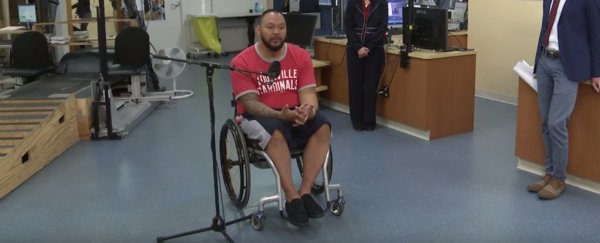Through a combination of electrical stimulation and intense physical training, a man with a complete spinal cord injury has regained the ability to independently stand up and move his legs.
Andrew Meas broke his neck in a motorcycle accident when he was just 28 years old. He was unable to walk, stand, or voluntarily move his legs, even after 21 months of rehabilitation and training following the accident.
Just over four years after the accident, researchers from the Kentucky Spinal Cord Injury Research Center at the University of Louisville paired his rehabilitation with something called spinal cord epidural stimulation (scES).
It's fairly invasive. It consisted of a device implanted over Meas's spinal column, providing electrical stimulation to the lumbosacral enlargement during physical training. An electrode lead was tunnelled to a pouch under the skin of the patient's abdomen, which contained the pulse generator.
Over the course of 44 months of physical training with scES, Meas has regained the ability to move his lower limbs, without needing the scES to do so.
"Activity-dependent plasticity can re-establish voluntary control of movement and standing after complete paralysis in humans even years after injury," said senior researcher Susan Harkema.
"This should open up new opportunities for recovery-based rehabilitation as an agent for recovery, not just learning how to function with compensatory strategies, even for those with the most severe injuries."
Meas was one of four participants in an earlier study by the same institution, all of whom regained some motor function through the use of physical activity and scES.
That initial nine-month training required daily, one-hour sessions - first standing, then stepping. Afterwards, Mease continued standing training for a year at home, before returning to the lab for a three-month training regime for both standing and stepping.
It was after this training that Meas was able to extend his knees, reach a standing position, maintain a standing position without assistance, and even stand on one leg. Moreover, he could do so without the aid of electrical stimulation.

Electrical stimulation to restore motor function in paralysis patients has been a growing field of research in the last few years.
In 2015, for example, a UCLA study found that spinal stimulation helped five paralysis patients regain some voluntary movement in their legs - although not enough to support their weight.
But a similar approach was later used in combination with a robotic exoskeleton to help a paralysed man walk again.
The researchers on Meas's case believe that his remarkable recovery can be attributed to the combination of activity and scES-based training which has remodelled the neuronal connections along the spinal cord.
They also believe that the amount of sheer effort Meas put into the training contributed as well.
"The voluntary component of him trying constantly with spinal stimulation on and while performing motor tasks can lead to unexpected recovery," said first researcher Enrico Rejc.
The long-term hard work and commitment seems to be a not insignificant part of the recovery process. The team found that in all participants, eight months of physical training and scES did not lead to any improvement without stimulation.
However, the results are promising, indicating that the spinal cord can, indeed, recover after a traumatic injury.
"The human nervous system can recover from severe spinal cord injury even years after injury. In this case, he was implanted with the stimulator four years after his injury. We saw motor recovery two years later - so six years after injury," Rejc said.
"It is commonly believed that one year from injury, you are classified as chronic and it's likely that you will not improve any more. This data is proof of principle that the human nervous system has much greater recovery capabilities than expected."
The research has been published in the journal Scientific Reports.
